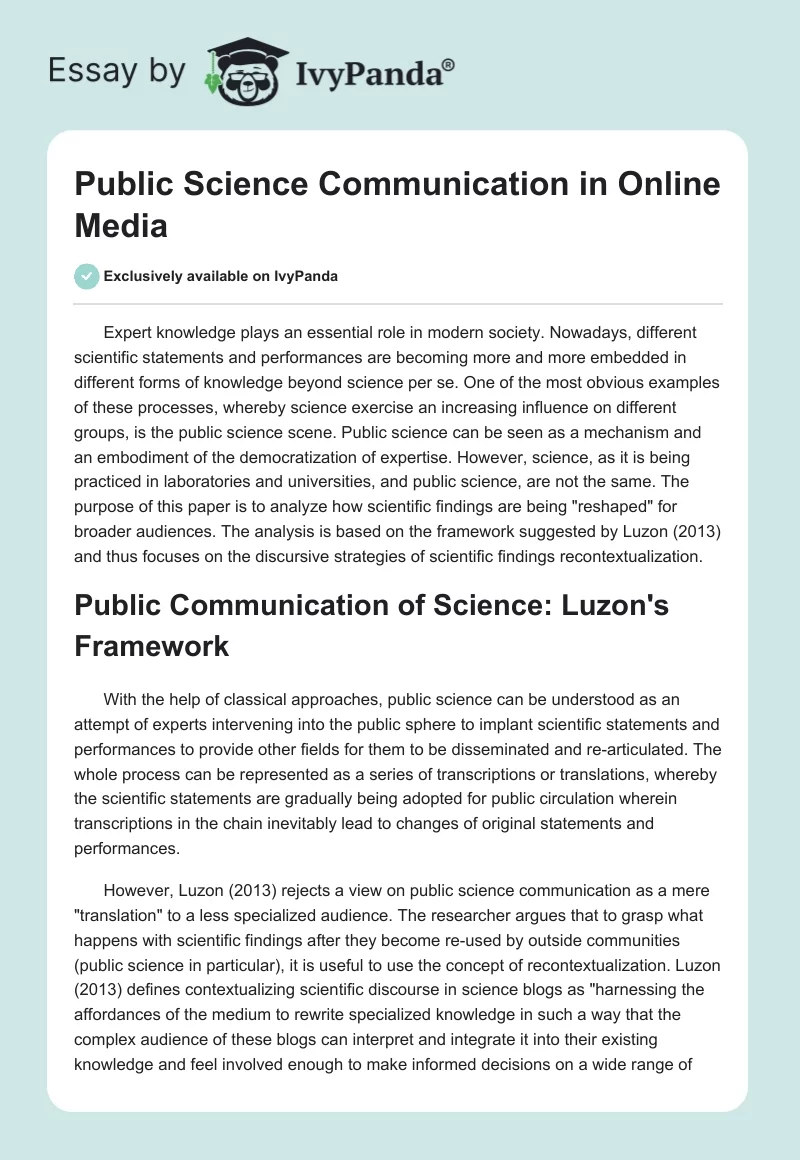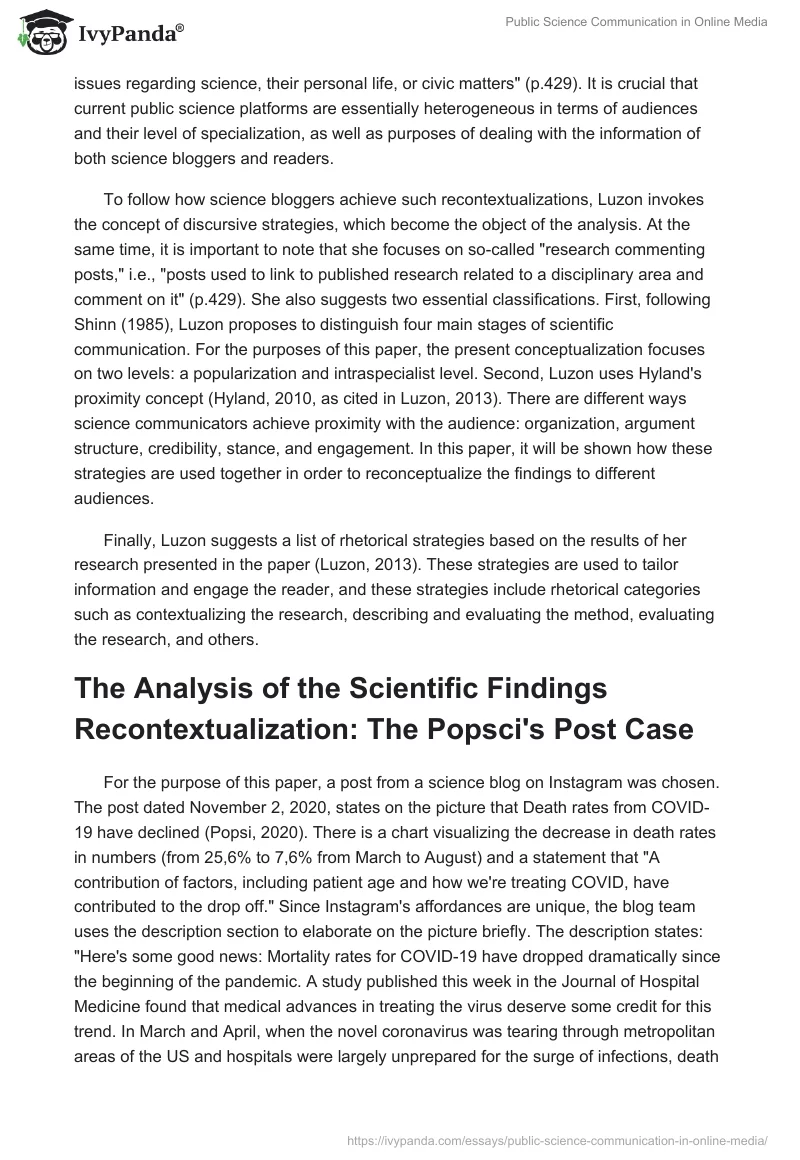Expert knowledge plays an essential role in modern society. Nowadays, different scientific statements and performances are becoming more and more embedded in different forms of knowledge beyond science per se. One of the most obvious examples of these processes, whereby science exercise an increasing influence on different groups, is the public science scene. Public science can be seen as a mechanism and an embodiment of the democratization of expertise. However, science, as it is being practiced in laboratories and universities, and public science, are not the same. The purpose of this paper is to analyze how scientific findings are being “reshaped” for broader audiences. The analysis is based on the framework suggested by Luzon (2013) and thus focuses on the discursive strategies of scientific findings recontextualization.
Public Communication of Science: Luzon’s Framework
With the help of classical approaches, public science can be understood as an attempt of experts intervening into the public sphere to implant scientific statements and performances to provide other fields for them to be disseminated and re-articulated. The whole process can be represented as a series of transcriptions or translations, whereby the scientific statements are gradually being adopted for public circulation wherein transcriptions in the chain inevitably lead to changes of original statements and performances.
However, Luzon (2013) rejects a view on public science communication as a mere “translation” to a less specialized audience. The researcher argues that to grasp what happens with scientific findings after they become re-used by outside communities (public science in particular), it is useful to use the concept of recontextualization. Luzon (2013) defines contextualizing scientific discourse in science blogs as “harnessing the affordances of the medium to rewrite specialized knowledge in such a way that the complex audience of these blogs can interpret and integrate it into their existing knowledge and feel involved enough to make informed decisions on a wide range of issues regarding science, their personal life, or civic matters” (p.429). It is crucial that current public science platforms are essentially heterogeneous in terms of audiences and their level of specialization, as well as purposes of dealing with the information of both science bloggers and readers.
To follow how science bloggers achieve such recontextualizations, Luzon invokes the concept of discursive strategies, which become the object of the analysis. At the same time, it is important to note that she focuses on so-called “research commenting posts,” i.e., “posts used to link to published research related to a disciplinary area and comment on it” (p.429). She also suggests two essential classifications. First, following Shinn (1985), Luzon proposes to distinguish four main stages of scientific communication. For the purposes of this paper, the present conceptualization focuses on two levels: a popularization and intraspecialist level. Second, Luzon uses Hyland’s proximity concept (Hyland, 2010, as cited in Luzon, 2013). There are different ways science communicators achieve proximity with the audience: organization, argument structure, credibility, stance, and engagement. In this paper, it will be shown how these strategies are used together in order to reconceptualize the findings to different audiences.
Finally, Luzon suggests a list of rhetorical strategies based on the results of her research presented in the paper (Luzon, 2013). These strategies are used to tailor information and engage the reader, and these strategies include rhetorical categories such as contextualizing the research, describing and evaluating the method, evaluating the research, and others.
The Analysis of the Scientific Findings Recontextualization: The Popsci’s Post Case
For the purpose of this paper, a post from a science blog on Instagram was chosen. The post dated November 2, 2020, states on the picture that Death rates from COVID-19 have declined (Popsi, 2020). There is a chart visualizing the decrease in death rates in numbers (from 25,6% to 7,6% from March to August) and a statement that “A contribution of factors, including patient age and how we’re treating COVID, have contributed to the drop off.” Since Instagram’s affordances are unique, the blog team uses the description section to elaborate on the picture briefly. The description states: “Here’s some good news: Mortality rates for COVID-19 have dropped dramatically since the beginning of the pandemic. A study published this week in the Journal of Hospital Medicine found that medical advances in treating the virus deserve some credit for this trend. In March and April, when the novel coronavirus was tearing through metropolitan areas of the US and hospitals were largely unprepared for the surge of infections, death rates for people in intensive care were as high as 25%. That number quickly fell to around seven percent as hospitals adapted to the pandemic. Tap link in bio for all the COVID-19 news you need to know this week” (Popsi, 2020).
First, it is essential to note that the language the team uses is concise for the reason that descriptions in Instagram do not allow for longreads. Second, the language is intended for the general public making the potential audience as large and heterogeneous as possible. The use of contractions like “Here’s” and expressions like “good news” make the message conveyed informal and friendly. Following Hyland’s concept of proximity with the reader and the ways science communicators achieve it, it is possible to say that in doing so, the Popsci team adapts rhetorical patterns to the audience’s expectations and needs (Hyland, 2010 as cited in Luzon, 2013).
Also, the functionality specific to Instagram does not include references like hyperlinks; thus, the original source becomes hard to follow. Although the team mentions the source (the Journal of Hospital Medicine), the traceability of the information is rather challenging. However, the team of Popsci expands their communication with the audiences and provides an opportunity for those interested in more details to read their message in more detail. An important feature of the description in Instagram provided above shows that the authors of the post recontextualize the original scientific findings in such a way, and they intend at increasing the traffic on their website blog by invoking such phrases like “COVID-19 news you need to know”. Clearly, not everyone is explicitly sure whether they need the information on the pandemic and what kind of information they are looking for.
Thus, this discursive strategy invokes rhetorics of engaging the readers by stating that they have already processed all the existing information related to COVID-19 and have picked just the relevant and credible pieces. An Instagram user is invited to navigate and travel from primary visuals conveying information to a more detailed textual source. In doing so, they recontextualize the same scientific findings for various platforms and audiences. The latter also happens because not everyone is ready to click the link and continue reading.
One switches from an Instagram post to a website blog article. In other words, one shifts between the levels of simplification and, most importantly, the levels of interactivity of the platforms. Now, one sees an article with a very compelling title: “We’re getting better at treating COVID-19” (Zisk, 2020). Although this blog is intended for science communication, this title shows that it is still a journalist article intended to capture and engage as diverse and broad an audience as possible. The recontextualization here suggests an uncareful generalization of scientific findings, which are explained further in a little bit more detail. Thus, public science rhetorics are fundamentally different from the scientific one since the latter does not allow for such a drastic change of the statement’s modality (Rezaev & Ivanova, 2019). For science to arrive at such generalizations, it is necessary to conduct a considerable amount of intra- and interdisciplinary national and international studies. However, the media blogs communicating scientific findings are not bound by such strict rules; thus, they can use such capturing hedges, mainly because the problem discussed is relevant worldwide. In doing so, they express a positive attitude, and it becomes clear that the findings presented will be favored with positive evaluations of research findings, which is outlined as a distinctive rhetorical strategy to recontextualize science information (Luzon, 2013).
In this weblog article, the reader first sees the exact repetition of the text from Instagram. The only difference is that the affordances of the weblog involve hyperlinks. One can click on the phrases “a study” and “deserve some credit” in the sentence “A study published this week in the Journal of Hospital Medicine found that medical advances in treating the virus deserve some credit for this trend.” The hyperlink “a study” actually leads to the original publication of the findings. The hyperlink “deserve some credit” leads to The New York Times’ article “Death Rates Have Dropped for Seriously Ill Covid Patients” (Rabin, 2020). In the latter split, one can see that there is a difference in audiences and, most importantly, fundamental differences in the way the scientific findings have been recontextualized. If the Popsci team aims at a discursive recontextualization for a large non-specialist audience, the article by Rabin (2020) seems to be intended at rather an interdisciplinary popularization. Although Luzon(2013) states that the interspecialist level usually happens in journals like Nature or Science, one can suggest that such it also happens on platforms with a more diverse audience. One of the reasons for that is that not all specialists involved in the problem for various reasons will turn to academic journals and instead look for information in some newspapers with an appropriate level of reflection.
Having clicked on the hyperlink to the original study, one can see the striking difference between the scientific discourse and the popularized version of it. No matter what the level of simplicity, i.e., different ways of “tailoring information to the assumed knowledge base of potential readers” (Lazu, 2013, p…) is, the popularizations aim at avoiding the discussion of particular terms and methods, like “multivariable logistic regression models,” “C statistic,” “average marginal effects,” and many others essential for the study’s outcomes. Thus, the popularizations do not engage the reader in a meaningful evaluation of the ways by which the scientists have arrived at a conclusion. In doing so, they implicitly leave out the questions of the research validity and reliability.
References
Luzón, M. J. (2013). Public communication of science in blogs: Recontextualizing scientific discourse for a diversified audience. Written Communication, 30(4), 428-457.
Popsi [@popsi]. (2020). Death rates from COVID-10 have declined. [Instagram post]. Web.
Rabin, R. C. (2020). Death Rates Have Dropped for Seriously Ill Covid Patients. The New York Times. Web.
Rezaev, A. V., & Ivanova, A. A. (2019). Is It Worth Doing Science Online? A Reflexive View on the Online Surveys. A Reflexive View on the Online Surveys. RAIS Conference Proceedings – The 14th International RAIS Conference on Social Sciences and Humanities, Web.
Zisk, R. (2020). We’re getting better at treating COVID-19. Popular Science. Web.


